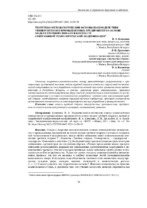Теоретико-методологические основы взаимодействия университетов и промышленных предприятий на основе модели тройной спирали в контексте современной технологической модернизации

Date
2021Publisher
Another Title
Theoretical and methodological foundations of interaction between universities and industrial enterprises based on the triple helix model in the context of modern technological modernization
Bibliographic entry
Клименко, В. А. Теоретико-методологические основы взаимодействия университетов и промышленных предприятий на основе модели тройной спирали в контексте современной технологической модернизации = Theoretical and methodological foundations of interaction between universities and industrial enterprises based on the triple helix model in the context of modern technological modernization / В. А. Клименко, Л. И. Дроздович, В. А. Казанцева // Экономическая наука сегодня : сборник научных статей / редкол.: С. Ю. Солодовников (гл. ред.) [и др.]. – Минск : БНТУ, 2021. – Вып. 14. – С. 50-56.
Abstract
Уточнены теоретико-методологические основы взаимодействия университетов и промышленных предприятий на основе модели тройной спирали в контексте современной технологической модернизации за счет разработки теоретико-методологических принципов этого взаимодействия в Республике Беларусь, а именно: равенства форм собственности; признания множественности институциональных форм участия университетов в капитализации их технико-организационных и технико-технологических разработок; создания сети коммуникаций тройной спирали; необходимости создания социально-научного сообщества; признания уникальности организационно-экономических механизмов внедрения научных разработок в промышленности.
Abstract in another language
The theoretical and methodological foundations of interaction between universities and industrial enterprises on the basis of the triple helix model in the context of modern technological modernization are clarified by developing theoretical and methodological principles of this interaction in the Republic of Belarus, namely: equality of ownership forms; recognition of multiple institutional forms of participation of universities in the capitalization of their technical, organizational and technological developments; creation of a triple helix communication network; the need to create a socioscientific community; recognition of the uniqueness of organizational and economic mechanisms for the introduction of scientific developments in industry.
